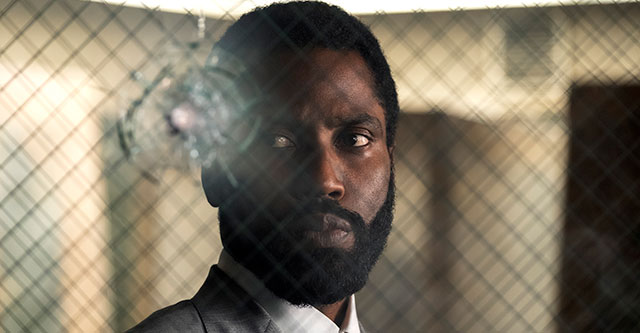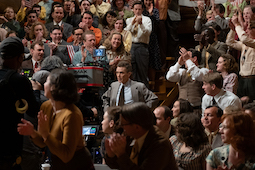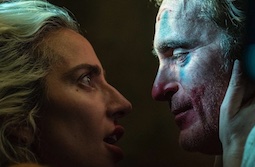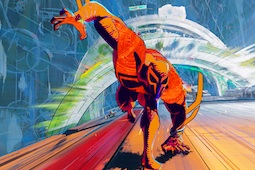
What exactly is Christopher Nolan's new movie Tenet about? And will it release on time to emerge as the saviour of the 2020 summer season?
Concrete answers to both of those questions are sadly lacking. But it can't be denied that every new Nolan movie creates a feverish sense of anticipation, as we speculate on what kind of arresting visuals and philosophical themes he has in store for us.
BlacKkKlansman's John David Washington stars as a globe-trotting operative (currently unnamed) who may or may not be embroiled in a deadly time travel/World War III conspiracy. It's hard to tell, but with handsome IMAX cinematography, a multitude of global locations and a huge budget (upwards of $220 million), there's no denying that Nolan has put his ambitious cards on the table.
Then there's the cast: Robert Pattinson (who also can't explain Tenet's plot), Kenneth Branagh, Michael Caine, Elizabeth Debicki, Aaron Taylor-Johnson, Clemence Poesy, Dimple Kapadia and Himesh Patel all star.
If previous Nolan films have taught us anything, it's that Tenet will surprise us. So, while we take a break from ruminating and obsessing over every little detail in the trailer, let's go back and celebrate some of those diabolically clever Nolan movie twists that left us stunned.
WARNING: SPOILERS AHEAD
1. Leonard killed his own wife – Memento (2000)
Nolan's calling card movie announced his predilection for non-linear storytelling. Memento is adapted from a short story by Nolan's brother Jonathan, and is a technical marvel, running two narratives simultaneously to depict the impact of short term memory loss.
The colour storyline runs in reverse order, compelling us to think in the manner of conflicted central character Leonard (Guy Pearce), who is on the hunt for the man who assaulted and killed his wife. At the same time, a storyline in black and white moves forward in a conventional manner, and it's assumed that the point at which the two tangents meet will be the end of the movie.
And so it goes, but there's a shocking revelation to see us out. Yes, Leonard was hit on the head in the middle of his wife's assault, but she didn't die in the attack. Instead, Leonard confuses the story of one Sammy Jenkis, a short term memory suffer who accidentally killed his spouse with an insulin overdose, with his own. Leonard, in fact, killed his wife with the overdose, and has propelled on a vengeful crusade of his own making, relying on polaroids, tattoos and more clues, while being spurred on with the help of Teddy (Joe Pantoliano)
Teddy reveals that he was the cop assigned to the assault case, and they in fact found the guilty party, 'John G', early on. However, Leonard didn't remember taking revenge, and Teddy was compelled to spin the mystery out once again. It's a revelation that's rife with undercurrents of loss and self-deception, propelling Nolan to a Best Adapted Screenplay nomination at the Oscars.
2. Ra's Al Ghul is still alive – Batman Begins (2005)
Following the critical success of Memento and Insomnia (2002), Christopher Nolan was entrusted with a prize comic book franchise. Following the disaster of 1997's Batman and Robin, distributor Warner was on the hunt for a talented young filmmaker who could reinvigorate the moribund Batman franchise.
The resulting film, Batman Begins, was hailed by many as the best so far, even moreso than the earlier Tim Burton movies. Nolan re-imagined Batman as an outcast vigiinate who weaponises fear to terrorise the criminals and thugs of Gotham. And it all begins with Bruce Wayne's (Christian Bale) training montage sequence at the hands of mysterious guru Ra's Al Ghul (Liam Neeson).
Once Wayne discovers that Al Ghul's plans for his home city of Gotham involve death and instruction, he abandons his mentor. It's assumed that Al Ghul has died, but he later re-emerges during a party at Wayne Manor, revealing that his diabolical partnership with Scarecrow (Cillian Murphy) is on course to create maximum destruction.
The eerie presentation of Al Ghul's return owes a lot to the typically excellent cinematography of Wally Pfister, a Nolan regular. But it's also a surprise to see Neeson portraying a villain, one whose apparently noble intentions towards Wayne were in fact anything but. Neeson usually plays morally upstanding characters, but in Nolan's film, the clever casting means that Gary Oldman, renowned for playing psychos, gets the good guy role of Jim Gordon.
3. Both Angier and Borden have doubles – The Prestige (2006)
There are, in fact, a multitude of twists on offer in Nolan's fiendishly intricate puzzle box thriller. Adapted from Christopher Priest's novel, The Prestige assumes the structure and emotional impact of the finest magic trick. The narrative proceeds in this manner, moving from the pledge (objects and/or characters are presented), to the turn (a twist turns something ordinary into something extraordinary), and the prestige (an apparently impossible final reveal that leaves the audience delightfully bamboozled).
Centrally, the movie is focused on the rivalry between two 19th century London magicians: working class Borden (Christian Bale) and upper-class Angier (Hugh Jackman). Although initially friends, a series of tragic incidents turns the two men against one another, as they each seek to perfect the ultimate magic trick. It's a classic Nolan movie, one of betrayal and deception, with unreliable narrators and flashbacks within flashbacks keeping us guessing.
Of course, we're anticipating Nolan's own prestige right from the start, and he more than delivers. In fact, it works on two levels: Borden is revealed to have an identical brother, Fallon, with whom he's been swapping all the way through the movie. But the real sucker punch resides with Angier or, to give him his proper name, Lord Caldlow, the English aristocratic identity that Angier has so carefully masked.
Angier is the one who has made the real sacrifice, deploying a machine designed by scientist Nikola Tesla (David Bowie). The device in fact creates a double of the operator, allowing one Angier to drop beneath the stage and drown, while the other emerges next to the audience to thunderous applause, having apparently jumped from one location to another. This literal life-or-death act has been repeated so many times, there are multiple Angiers located in tanks beneath the stage, as the final shot makes clear.
Deviously, Nolan has cued us into this from the off, with the opening shot of duplicated hats telling us exactly where we're going. But as Michael Caine's props assistant Cutter says, "You don't want to work it out... You want to be fooled."
4. Cobb used inception on his wife Mal – Inception (2010)
Christopher Nolan put brains and brawn in the service of an original blockbuster property with Inception. Without the advantage of Batman iconography to back him up, Nolan took an enormous gamble in trusting the audience to keep up with this labyrinthine mind-heist thriller. That people lapped it up to the tune of $800 million worldwide was vindication for the Nolan brand of smart, character-driven popcorn entertainment.
Like the earlier Memento and The Prestige, Inception plays right into the notion of the unreliable nature of memory. But whereas Memento was about the loss of identity, and The Prestige fooled us with deceptively narrated diary entries, Inception literalises the essence of our subconscious. In a clear sign of his escalating confidence as a filmmaker, Nolan is able to turn the various layers of the mind into a visual and emotional treat. Physics are routinely defied and events occupy differing amounts of time, relative to the level of consciousness the characters are occupying.
The real kicker comes when team leader Dom Cobb (Leonardo DiCaprio) reveals what he did to his late wife Mal (Marion Cotillard). Cobb's own subconscious is haunted by Mal's malevolent presence, and we finally realise that this has a tragic bearing: he undertook inception on her, the very insidious tactic that Dom and his team are using on millionaire tycoon Robert Fischer (Cillian Murphy).
With Fischer, Dom's unit is aiming to plant subconscious layers of doubt that will lead to the eventual dismantling of his business empire. But with Mal, it was personal: trapped in subconscious limbo with her husband, this had become her reality. Dom, therefore, planted the idea in Mal's head that this so-called reality was, in fact, a dream, aiming to coax her back into the real world. But it horribly backfired when the confused Mal later killed herself, a plot development that adds the gripping weight of human tragedy to a tricksy thriller.
5. Talia is the mastermind of Gotham City's destruction (2012)
In Inception, Marion Cotillard played a character whose apparently evil intentions are revealed to have tragic undercurrents. In The Dark Knight Rises, it almost works in reverse: her character Miranda Tate is introduced as an ally and love interest of Bruce Wayne, before it's revealed that she is the ruthless kingpin behind it all.
Nolan connects everything back to the events of Batman Begins, revealing that Miranda is in fact named Talia, the secret daughter of Ra's Al Ghul. Nolan stays loyal to his themes of memory and deception, as flashbacks apparently reveal Bane's (Tom Hardy) escape from an underground prison. But in a shocking twist, it's shown that Bane wasn't the child who escaped, but Talia, and she now plans a terrible revenge on Gotham City.
Talia aims to continue the legacy of her father's League of Shadows organisation, and Cotillard is effective at demonstrating the character's steely resolve. (Shame about the poorly executed death scene, though.) Few people have been able to sneak up on Batman and deploy the "slow knife" that "cuts deepest", but such is the nature of Talia's treachery.
6. The messages are from Cooper – Interstellar (2014)
Nolan's sweeping sci-fi epic Interstellar begins as a journey to find a new home for mankind. But it becomes seriously weird and trippy come the end, with an excursion into a fourth dimension that has serious ramifications for astronaut character, Cooper (Matthew McConaughey).
Nolan has always messed around with the concept of past, present and future. But it's never been as brazen as the moment where Cooper realises the nature of the messages written in dust on his daughter Murph's bookshelf.
Both Cooper and Murph (Mackenzie Foy) were witness to this when she was a child, and she mistakenly attributed it to the actions of a ghost. Immediately afterward, Cooper left Earth and his daughter behind to find a new habitable planet on which humans can live. By the end of the movie, Cooper has been isolated in space for so long, Murphy has grown up (played as an adult by Jessica Chastain).
Nevertheless, Cooper is able to do the time warp, quite literally: it's revealed that he was the one writing the messages for young Murph, reaching out from the void to help inform the emotional voyage of her older self. Confused? That's unsurprising.
The gist of it is, he's able to transmit quantum data, interpreted by the older Murph in such a manner that ensures the plan for mankind's survival. Yep, we needed a stiff drink after this one.
Tenet is scheduled for release on 26th August 2020. Got a favourite Nolan twist of your own? Let us know @Cineworld.











.jpg)


.jpg)
.png)






